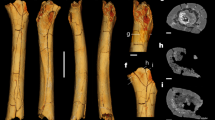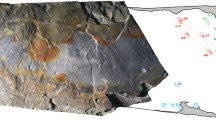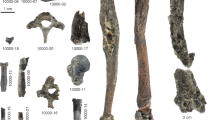Abstract
Analysis of a newly discovered specimen of the Late Triassic prolacertiform reptileLangobardisaurus, along with further analyses of the postcranial skeletons of previously described specimens, suggests that a bipedal configuration without a parasagittal gait was possible during rapid locomotion, as previously suggested for the related genus,Macrocnemus, and also while standing and walking. Morphological evidence and size-related criteria are consistent with a facultative digitigrade configuration while standing erect. The elongation of the neck, a hallmark of the prolacertiforms, may have assisted these efforts, as inChlamydosaurus, an extant facultatively bipedal lizard with a convergent morphology. This hypothesis should yield new insights into the mode of life ofLangobardisaurus and other prolacertiform sister taxa.
Similar content being viewed by others
References
Benton M. J. (1985): Classification and phylogeny of the diapsid reptiles. — Zool. Journ. Linn. Soc.84: 97–164; London.
Benton M. J. &Allen, J. (1997):Boreopricea from the Lower Triassic of Russia and the relationships of the prolacertiform reptiles. — Palaeontology40: 931–953; London.
Brinkman M D. (1981): The hind limb step cycle ofIguana and primitive reptiles. — Journ. Zool. Soc. London181: 91–103; London.
Berman D. S., Reisz R. R., Scott D. Henrici A. C., Sumida S. S. &Martens T. (2000): Early Permian bipedal reptile — Science290: 969–972; Washington.
Carrier, D., Heglund, N. &Earls, K. (1994): Variable gearing during locomotion in the human musculoskeletal system. — Science265: 651–653; Washington.
Camp, C. L. (1945a):Prolacerta and the Protorosaurian reptiles. — part 1. American Journal of Sciences243: 17–32; New Haven.
Dilkes, D. W. (1998): The Early triassic rhynchosaurMesosuchus browni and the interrelationships of basal archosauromorph reptiles. — Phil. Trans. Roy. Soc. London B.353: 501–541; London.
Evans, S. E. (1980): The skull of a new eosuchian reptile from the Lower Jurassic of South Wales. — Zool Journ. Linn. Soc.70: 203–264; London.
Evans, S. E. (1984): The classification of the Lepidosauria. — Zool. Journ. Linn. Soc.73: 81–116; London.
Evans, S. E. (1988): The early history and the relationships of the Diapsida. — InBenton, M. J. [ed]: The Phylogeny and Classification of the Tetrapods,1: 221–260. Clarendon Press., Oxford.
Fieler C. L. &Jayne B. (1998): Effects of speed on the hindlimb kinematics of the lizardDipsosaurus dorsalis. — Journ. Exp. Biol.201, 609–622, London.
Gow, C. (1975): The morphology and relationships ofYoungina capensis Broom andProlacerta broomi Parrington. — Paleontologia Africana.18: 89–131; Cape Town.
Hamley T. (1990): Functions of the tail in bipedal locomotion of lizards, dinosaurs and pterosaurs. — Mem. Qd. Mus28: 153–158 Brisbane.
Irschick D. J. &Jayne B. C. (1999): Comparative three dimensional kinematics of the hindlimb for high speed bipedal and quadrupedal locomotion of lizards. — Journ. Exp. Biol.202: 1047–1065; London.
Jadoul, F.,Masetti, D.,Cirilli, S.,Berra, F.,Claps, S. &Frisia, S. (1994): Norian-Rhaetian stratigraphy and palaeogeographic evolution of the Lombardy basin (Bergamasc Alps). — 15th IAS Regional Meeting, April 1994, Ischia, Italy, Field excursion, Excursion B1: 5–38, Naples.
Jalil, N.-E. (1997): A new prolacertiform diapsid from the Triassic of North Africa and the interrelationships of the Prolacertiformes. — Journ. Vert. Paleont.17: 506–525.
Muscio G. (1996): Preliminary note on a specimen of Prolacertiformes (Reptilia) from the Norian (Late Triassic) of Preone (Udine, North Eastern Italy). — Gortania18: 33–40.
Nopcsa, F. Baron (1930): Notizen überMacrochemus bassanii nov., gen. et spec. — Centralbl., Min.1930: 252–255.
Nopcsa, F. Baron (1931):Macrocnemus nichtMacrochemus. — Centralbl. Min.1931: 655–656.
Olsen, P. E. (1979): A new aquatic eosuchian from the Newark Supergroup (Late Triassic — Early Jurassic) of North Carolina and Virginia. — Postilla,176: 1–14.
Olsen, P.E. &Jonson, A.K. (1994): Field guide to Late Triassic tetrapod sites in Virginia and North Carolina. — InFraser, N.C. &Sues, H.D. [eds], in the Shadow of the dinosaurs, 408–430; Cambridge University press; Cambridge.
Peabody F. E., (1948): Reptile and amphibian trackways from the Moenkopi Formation of Arizona, and Utah. — University. Of California Publications, Bulletin of the Department of Geological Sciences27: 325–340.
Peters, D., (2000a): Description and Interpretation of Interphalangeal Lines in Tetrapods. Ichnos 7(1), 11–41.
Peters, D. (2000b): A Redescription of Four Prolacertiform Genera and Implications for Pterosaur Phylogenesis. — Riv. It. Paleont. Strat.106: 293–336.
Renesto, S. (1994): A new prolacertiform reptile from the Late Triassic of Northern Italy. — Riv. It. Paleont. Strat.100: 285–306.
Renesto S. &Dalla Vecchia F. (2000): The unusual dentition and feeding habits of the prolacertiform reptileLangobardisaurus (late Triassic, Northern Italy). — Journ. Vert. Paleont.20 (3): 662–627.
Rewcastle S. C. (1980): Form and function in lacertilian knee and mesotarsal joints; a contribution to the analysis of sprawling locomotion. — J. Zool. Lond.191: 147–170.
Rieppel, O. (1989): The hind limb ofMacrocnemus bassani (Nopcsa) (Reptilia, Diapsida): development and functional anatomy. — Journ. Vert. Paleont.9:373–387.
Roghi G., Mietto, P. &F. M. Dalla Vecchia (1995): Contribution to the conodont biostratigraphy of the Dolomia di Forni (Upper Triassic, Carnia, NE Italy). — Mem. Sci. Geol. Padova48: 125, 133.
Russell A. P. &Bauer A. M (1992): The m. caudifemoralis longus and its relationships to caudal autotomy and locomotion in lizards (Reptilia, Sauria). — J. Zool. Lond.227: 127–143.
Shine R &Lambeck R. (1989): The ecology of Frillneck Lizard,Chlamydosaurus kingii (Agamidae) in tropical Australia. — Aust. Wildl. Res.16: 491–500.
Snyder R. C. (1954): The anatomy and function of the pelvic girdle and hind limb in lizard locomotion. — Am. Journ. Anat.95 (1): 1–137.
Snyder R. C. (1962): Adaptations for bipedal locomotion of Lizards — Am. Zool.2:191–203.
Wild, R. (1973): Die Triasfauna der Tessiner Kalkalpen XXIII.Tanystropheus longobardiscus Bassani (Neue Ergebnisse). — Abhandl. Schweiz. Paläont. Gesells.95: 1–162.
Author information
Authors and Affiliations
Rights and permissions
About this article
Cite this article
Renesto, S., Dalla Vecchia, F.M. & Peters, D. Morphological evidence for bipedalism in the Late Triassic prolacertiform reptileLangobardisaurus . Senckenbergiana lethaea 82, 94–106 (2002). https://doi.org/10.1007/BF03043775
Received:
Accepted:
Issue Date:
DOI: https://doi.org/10.1007/BF03043775




